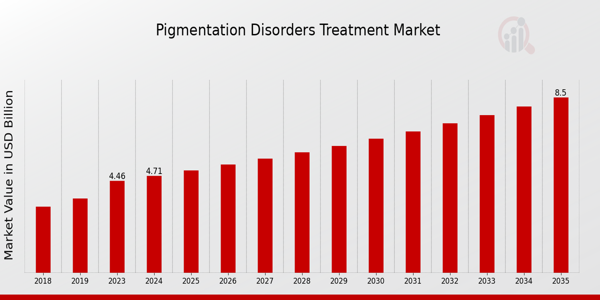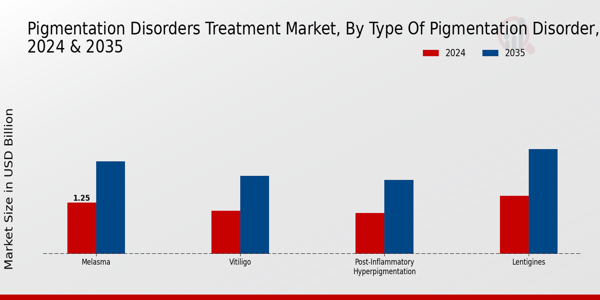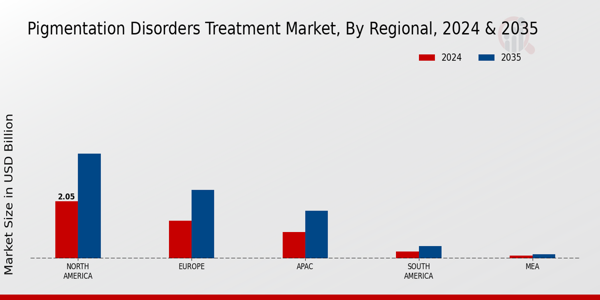Pigmentation Disorders Treatment Market Overview
The Pigmentation Disorders Treatment Market Size was estimated at 4.46 (USD Billion) in 2023. The Pigmentation Disorders Treatment Market is expected to grow from 4.71(USD Billion) in 2024 to 8.5 (USD Billion) by 2035. The Pigmentation Disorders Treatment Market CAGR (growth rate) is expected to be around 5.52% during the forecast period (2025 - 2035)
Key Pigmentation Disorders Treatment Market Trends Highlighted
The pigmentation disorders treatment market is driven by rising awareness about skin health foods and the growing prevalence of pigmentation disorders among various demographics. Factors such as increased exposure to UV radiation, pollution, and changing lifestyle habits are contributing to the rise in these conditions.
Additionally, advancements in dermatological treatments and the availability of effective therapeutic options have significantly increased the demand for specialized products targeting pigmentation issues. As more people prioritize skin health, the market is experiencing robust growth, with consumers seeking both clinical and over-the-counter solutions.
Opportunities abound in this evolving landscape as new technologies and research into skin disorders open doors for innovative treatments and formulations. The increasing prominence of personalized medicine allows for tailored therapies that address individual patient needs. There is also a growing emphasis on non-invasive treatment options, which can attract a wider consumer base. Emerging markets present significant growth potential as the demand for effective skincare solutions rises in countries with increasing awareness and disposable income.
In recent times, there has been a notable trend towards natural and organic products, driven by consumer preferences for safer and environmentally friendly solutions.Social media and influencer campaigns are playing a crucial role in educating consumers about various pigmentation disorders and available treatments.
Moreover, the integration of digital health technologies, such as telemedicine, is expanding access to consultations and tailored care, making it easier for patients to seek help. This shift towards technology-enabled solutions and increased consumer engagement indicates a dynamic future for the pigmentation disorders treatment market, marked by innovation and responsiveness to consumer needs.

Source: Primary Research, Secondary Research, Market Research Future Database and Analyst Review
Pigmentation Disorders Treatment Market Drivers
Increasing Incidence of Pigmentation Disorders
The Pigmentation Disorders Treatment Market is primarily driven by the increasing prevalence of various pigmentation disorders such as melasma, vitiligo and post-inflammatory hyperpigmentation. These conditions affect individuals of all ages and genders, leading to a growing demand for effective treatment options.
Factors contributing to the rising incidence include genetic predispositions, environmental pollutants, and lifestyle choices such as excessive sun exposure and poor dietary habits.As awareness about these disorders grows, more people are seeking dermatological care and treatment solutions, creating a robust demand for innovative therapies in the market.
Healthcare providers and researchers are actively working to develop and enhance treatments to address these conditions more effectively. The shift towards cosmetic applications of pigmentation treatments further expands the market, catering to individuals looking for both therapeutic and aesthetic solutions.
The increasing awareness and acceptance of skin care services among the general public drives further development in the Pigmentation Disorders Treatment Market. This growth is expected to persist with the availability of health education and services, thus treatment options to become more accessible globally. Therefore, the market is expected to grow substantially because of the necessity to manage and treat disorders of pigmentation among different types of patients.
Advancements in Treatment Options
The Pigmentation Disorders Treatment Market is benefiting from rapid advancements in treatment technologies and methodologies. Innovations in pharmacological treatments, inclusive of topical agents, oral medications, and advanced laser therapies, are enhancing the efficacy and safety of available solutions. Emerging treatments using biotechnological approaches are also entering the market, offering more targeted therapies that reduce side effects and increase patient satisfaction.
This evolution in treatment options allows for a more personalized approach to address individual needs, thus boosting patient compliance and overall treatment outcomes. The ongoing research and development efforts, alongside clinical trials, are expected to introduce new modalities that can revolutionize how pigmentation disorders are treated.
Rising Awareness and Education
Rising awareness and education about pigmentation disorders significantly contribute to the market's growth. Increased access to information through online platforms, social media, and educational campaigns helps demystify these conditions, encouraging individuals to seek timely treatment. As patients become more informed about available therapies, their likelihood of pursuing professional help increases, thereby driving demand for effective solutions in the Pigmentation Disorders Treatment Market.
Pigmentation Disorders Treatment Market Segment Insights
Pigmentation Disorders Treatment Market Type of Pigmentation Disorder Insights
The pigmentation disorders treatment market is segmented by Type of Pigmentation Disorder, encompassing various categories such as Melasma, Vitiligo, Post-Inflammatory Hyperpigmentation, and Lentigines. This diverse segmentation reflects the intricate nature of pigmentation disorders and offers valuable insights into the treatment landscape. In 2024, Melasma will be valued at 1.25 USD Billion, making it a significant player in the market due to its prevalence among individuals, predominantly affecting women during their reproductive years.
This type of pigmentation disorder is often triggered by hormonal changes, contributing to its fast-growing treatment demand, which is projected to reach 2.25 USD Billion by 2035. Vitiligo, another notable category, is valued at 1.05 USD Billion in 2024, representing a substantial portion of the pigmentation disorders treatment market revenue. The rapid progression of this disorder and its psychological impact on patients highlights the urgency for effective treatment options, with an anticipated market growth of 1.9 USD Billion by 2035.
Post-Inflammatory Hyperpigmentation, valued at 1.0 USD Billion in 2024, is a prominent condition often resulting from skin injuries or inflammation, making it a critical consideration in dermatological treatments. As awareness surrounding skin health grows, the demand for treatment in this sector is expected to rise, reaching approximately 1.8 USD Billion by 2035.
Lentigines, valued at 1.41 USD Billion in 2024, dominates this segment while indicating a growing interest in anti-aging solutions and skincare products addressing photodamage. Lentigines, often referred to as age spots, account for a significant part of skin aging concerns. Its growth trajectory is set to elevate its market valuation to 2.55 USD Billion by 2035, illustrating consumers' investments in preventive treatments.
The pigmentation disorders treatment market segmentation provides a glimpse into the various conditions, with each type of disorder having unique treatment needs and market dynamics, reflecting ongoing trends and changing consumer preferences in skincare. With the expected growth in these areas, significant opportunities emerge for market players to innovate and meet the needs of consumers suffering from these dermatological concerns, thereby propelling market growth.
Enhanced awareness of different disorders and their treatments continues to shape the landscape, presenting drivers for both market expansion and the development of specialized care solutions, which is essential for addressing the diverse needs within the Pigmentation Disorders Treatment Market.

Source: Primary Research, Secondary Research, Market Research Future Database and Analyst Review
Pigmentation Disorders Treatment Market Treatment Type Insights
The pigmentation disorders treatment market with various treatment types shaping the landscape of this market. Among these treatments, Topical Treatments hold a significant position as they are often the first line of defense for individuals suffering from pigmentation issues, providing accessibility and convenience to patients.
Laser Therapy is increasingly recognized for its effectiveness in targeting specific lesions, thereby promoting market growth through technological advancements.Surgical Treatments, while less common, play a critical role in severe cases where other methods prove inadequate, contributing to the overall market share.
Phototherapy is also gaining traction as it offers a non-invasive alternative that can yield substantial results, making it an attractive option for many sufferers of pigmentation disorders. The market is driven by factors such as rising awareness about skin health, an increase in cosmetic procedures, and the growing prevalence of pigmentation disorders.
Despite the promising growth trajectory, challenges like the high cost of advanced treatments and the lack of skilled professionals can hinder market expansion.The pigmentation disorders treatment market data reflects a dynamic interplay between these treatment types, each contributing to the overall performance and future opportunities within the industry.
Pigmentation Disorders Treatment Market End User Insights
The pigmentation disorders treatment market showcases a growing interest in treatment options across various End User categories. Hospitals play a critical role in this market, providing specialized care and advanced treatment facilities for patients with pigmentation disorders.
Dermatology Clinics also contribute significantly, focusing on personalized treatment plans and consultations, which are essential for managing these conditions effectively. Homecare settings are becoming increasingly relevant as patients seek convenient treatment options, especially for mild to moderate cases.
This trend underscores the need for at-home therapies and monitoring solutions, catering to patient preferences for comfort and accessibility. As the pigmentation disorders treatment market data reflects, the increasing awareness of skin health and rising incidence of pigmentation disorders drive the demand across all End User segments, creating opportunities for innovation and market growth.
The market statistics highlight a clear shift towards a multi-setting approach that enhances patient access to treatments, ultimately contributing to a more comprehensive management of pigmentation disorders.
Pigmentation Disorders Treatment Market Chemical Classification Insights
The pigmentation disorders treatment market is poised for growth with a significant focus on the Chemical Classification segment, which has shown robust market dynamics. Key players in this segment include Tyrosinase Inhibitors, Retinoids, Hydroquinone, and Kojic Acid, each serving unique roles in the treatment of pigmentation disorders.
Tyrosinase Inhibitors are particularly important as they help reduce melanin synthesis, which is vital for conditions like hyperpigmentation.Retinoids, recognized for their ability to promote skin cell turnover and improve skin texture, have also gained traction due to their dual benefits.
Hydroquinone is known as a potent lightning agent, dominating market share due to its effectiveness, while Kojic Acid, derived from fungi, is gaining popularity for its natural ingredient profile. The diverse range of these chemical agents not only addresses various skin issues but also reflects a growing consumer preference for both clinical and over-the-counter treatments.
Market growth is driven by increasing awareness of skin health, coupled with advancements in dermatological formulations, creating opportunities for further innovations within the Pigmentation Disorders Treatment Market.
Pigmentation Disorders Treatment Market Regional Insights
The pigmentation disorders treatment market is projected to experience notable growth across various regions. North America is anticipated to take the lead with a valuation of 2.05 USD Billion in 2024, increasing to 3.75 USD Billion by 2035, showcasing its majority holding in the market due to advanced healthcare infrastructure and increasing awareness regarding pigmentation disorders.
Europe follows with a significant valuation of 1.35 USD Billion in 2024, expected to reach 2.45 USD Billion in 2035, driven by robust research and development initiatives in dermatology.The Asia-Pacific (APAC) region, valued at 0.95 USD Billion in 2024 and projected to increase to 1.7 USD Billion in 2035, is witnessing rising demand for effective treatment solutions due to a growing population and increasing disposable income.
South America, while smaller in comparison, holds a valuation of 0.25 USD Billion in 2024, expected to rise to 0.45 USD Billion by 2035, indicating a developing market potential. Lastly, the Middle East and Africa (MEA) region represents an emerging market in the pigmentation disorders treatment market, valued at 0.11 USD Billion in 2024 and growing to 0.15 USD Billion in 2035, presenting opportunities for expansion in healthcare access and treatment awareness.
This regional segmentation highlights diverse market dynamics, with North America and Europe dominating due to established healthcare systems, while APAC shows significant growth potential driven by economic development.

Source: Primary Research, Secondary Research, Market Research Future Database and Analyst Review
Pigmentation Disorders Treatment Market Key Players and Competitive Insights
The pigmentation disorders treatment market is characterized by numerous key players engaged in the development of innovative solutions targeting a variety of skin conditions, including hyperpigmentation and vitiligo. This market has witnessed significant growth due to an increasing demand for effective treatments and the rising prevalence of pigmentation disorders globally. Competitive dynamics include strategies such as product launches, mergers and acquisitions, and collaborations among pharmaceutical companies.
Investment in research and development has also intensified, aimed at providing safer and more efficacious options tailored to patients’ needs. As demand for specialized skincare and dermatological products grows, companies are continually refining their offerings and exploring new therapeutic approaches to maintain a competitive edge.
Revance Therapeutics, Inc. is recognized for its strong presence in the pigmentation disorders treatment market, standing out for its proprietary technologies and product offerings. The company has made significant strides by focusing on innovative treatment modalities that offer distinct advantages over traditional therapies. Revance's commitment to research and development has resulted in a robust pipeline of products designed to address various pigmentation disorders effectively.
Their ability to leverage advanced biotechnology not only enhances treatment efficacy but also aims to improve patient outcomes and satisfaction. As a dynamic player in the market, Revance Therapeutics, Inc. continues to prioritize patient-centric solutions that align well with evolving dermatological needs.
Valeant Pharmaceuticals International Inc. also holds a significant market position in the pigmentation disorders treatment market, noted for its broad portfolio of dermatological products. The company emphasizes strategic partnerships and acquisitions to bolster its position in the competitive landscape. Valeant's extensive experience in dermatology, combined with a focus on research-driven solutions, allows it to deliver a range of treatment options that cater to diverse patient populations.
The company has been successful in enhancing brand awareness and optimizing distribution channels, ensuring greater accessibility of its products. Through these strategies, Valeant Pharmaceuticals International Inc. is well-positioned to capitalize on the growing demand for pigmentation disorder treatments, reinforcing its status as a key player in the market.
Key Companies in the Pigmentation Disorders Treatment Market Include
- Revance Therapeutics, Inc.
- Valeant Pharmaceuticals International Inc.
- Mylan N.V.
- Roche Holding AG
- Eli Lilly and Company
- Galderma S.A.
- Aclaris Therapeutics, Inc.
- Hugel, Inc.
- Johnson and Johnson
- Paxman Coolers Limited
- Incyte Corporation
- Sun Pharmaceutical Industries Ltd.
- AbbVie Inc.
- Merck and Co., Inc.
Pigmentation Disorders Treatment Market Industry Developments
-
Q4 2024: Kaya Clinic launches Klear AI platform for personalized skin care Kaya Clinic introduced the Klear AI platform, which utilizes a dataset of over 4,000 Indian skin images to provide personalized skin care plans for pigmented skin types based on real-time image analysis.
Incyte Corporation and Sun Pharmaceutical Industries Ltd. are also emerging as significant players, focusing on developing innovative solutions for pigmentation disorders. Growth in market valuation is notably evident, driven by increased investments and heightened demand for effective treatment options, contributing to an overall positive outlook for the sector despite ongoing challenges.
Pigmentation Disorders Treatment Market Segmentation Insights
Pigmentation Disorders Treatment Market Type of Pigmentation Disorder Outlook
- Melasma
- Vitiligo
- Post-Inflammatory Hyperpigmentation
- Lentigines
Pigmentation Disorders Treatment Market Treatment Type Outlook
- Topical Treatments
- Laser Therapy
- Surgical Treatments
- Phototherapy
Pigmentation Disorders Treatment Market End User Outlook
- Hospitals
- Dermatology Clinics
- Homecare Settings
Pigmentation Disorders Treatment Market Chemical Classification Outlook
- Tyrosinase Inhibitors
- Retinoids
- Hydroquinone
- Kojic Acid
Pigmentation Disorders Treatment Market Regional Outlook
- North America
- Europe
- South America
- Asia Pacific
- Middle East and Africa
| Attribute/Metric Source: |
Details |
| MARKET SIZE 2023 |
4.46(USD Billion) |
| MARKET SIZE 2024 |
4.71(USD Billion) |
| MARKET SIZE 2035 |
8.5(USD Billion) |
| COMPOUND ANNUAL GROWTH RATE (CAGR) |
5.52% (2025 - 2035) |
| REPORT COVERAGE |
Revenue Forecast, Competitive Landscape, Growth Factors, and Trends |
| BASE YEAR |
2024 |
| MARKET FORECAST PERIOD |
2025 - 2035 |
| HISTORICAL DATA |
2019 - 2024 |
| MARKET FORECAST UNITS |
USD Billion |
| KEY COMPANIES PROFILED |
Revance Therapeutics, Inc., Valeant Pharmaceuticals International Inc., Mylan N.V., Roche Holding AG, Eli Lilly and Company, Galderma S.A., Aclaris Therapeutics, Inc., Hugel, Inc., Johnson and Johnson, Paxman Coolers Limited, Incyte Corporation, Sun Pharmaceutical Industries Ltd., AbbVie Inc., Merck and Co., Inc. |
| SEGMENTS COVERED |
Type of Pigmentation Disorder, Treatment Type, End User, Chemical Classification, Regional |
| KEY MARKET OPPORTUNITIES |
Rising prevalence of pigmentation disorders, Growing demand for innovative therapies, Development of personalized medicine solutions, Expansion of online pharma platforms, Increasing awareness and diagnosis rates |
| KEY MARKET DYNAMICS |
Increasing prevalence of pigmentation disorders, Growing demand for personalized treatments, Advancements in dermatological technology, Rising awareness of skin health, Expanding geriatric population |
| COUNTRIES COVERED |
North America, Europe, APAC, South America, MEA |
Frequently Asked Questions (FAQ):
The estimated market size of the Global Pigmentation Disorders Treatment Market in 2024 is valued at 4.71 USD billion.
By 2035, the expected value of the Global Pigmentation Disorders Treatment Market is 8.5 USD billion.
The compound annual growth rate (CAGR) for the Global Pigmentation Disorders Treatment Market from 2025 to 2035 is projected at 5.52%.
North America is expected to have the highest market value in 2024, valued at 2.05 USD billion.
The projected market value for the APAC region in 2035 is 1.7 USD billion.
The major types of pigmentation disorders included in the market analysis are Melasma, Vitiligo, Post-Inflammatory Hyperpigmentation, and Lentigines.
The market size for Melasma in 2024 is valued at 1.25 USD billion.
Key players in the Global Pigmentation Disorders Treatment Market include Revance Therapeutics, Valeant Pharmaceuticals, and Eli Lilly among others.
The expected market value for Post-Inflammatory Hyperpigmentation in 2035 is 1.8 USD billion.
Growth opportunities within the Global Pigmentation Disorders Treatment Market include increasing awareness and advancements in treatment options.

















